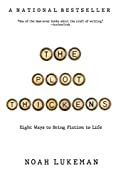The Plot Thickens: 8 Ways to Bring Fiction to Life by Noah Lukeman
Get your free copy of "The Plot Thickens: 8 Ways to Bring Fiction to Life by Noah Lukeman. "
Description
Review
“One of the best-ever books about the craft of writing. It is a book
that can change the world of every writer who embraces Lukeman’s ideas.
His classroom on paper should be on every writer’s shelf to be read
again and again.” ---Authorlink
“Full
of practical common sense about how to write fiction and [he] answers
many of the difficult questions first novelists ask themselves.”
---Michael Korda, author of Making the List
“Lukeman’s
advice is practical---and often entails multiple, time-consuming
steps---without a hint of the flakiness that creeps into many writing
guides. Though Lukeman works with books, he wisely asserts that the
observations in this volume are applicable to all types of imaginary
writing, from film to poetry. Indeed, it is a worthy addition to any
writer’s reference shelf.” ---Publishers Weekly
“A godsend...The Plot Thickens
is not the type of book you want to check out from the library or
borrow from a friend. It is the type of book you need to purchase so it
can sit on your desk, dog-eared and underlined, worn from years of
overuse.” ---Prairieden.com
"One of the best-ever books about the craft of writing." (Authorlink )
"A highly useful book that is written in an accessible style and filled with valuable examples." (The Writer )
"A written version of the mentor you always wished you could have." (Midwest Book Review )
"The type of book you need to purchase so it can sit on your desk, dog-eared and underlined." (Prarieden.com )
"Lukeman
understands... what makes for excellent, not just bestselling, fiction.
Treat yourself to his superbly written reference guide." (Netauthor.org )
Product Description
As
a literary agent, Noah Lukeman hears thousands of book pitches a year.
Often the stories sound great in concept, but never live up to their
potential on the page. Lukeman shows beginning and advanced writers how
to implement the fundamentals of successful plot development, such as
character building and heightened suspense and conflict. Writers will
find it impossible to walk away from this invaluable guide---a veritable
fiction-writing workshop---without boundless new ideas.
Noah
Lukeman is a New York literary agent whose clients include winners of
the Pulitzer Prize and American Book Award, National Book Award
finalists, Edgar Award finalists, New York Times bestselling authors,
and the faculty of esteemed universities. He has worked as a manager in
Artists Management Group, and is currently president of Lukeman Literary
Management Ltd. He is also author of the bestselling The First Five
Pages, now part of the curriculum in many universities.
“One of
the best-ever books about the craft of writing. It is a book that can
change the world of every writer who embraces Lukeman’s ideas. His
classroom on paper should be on every writer’s shelf to be read again
and again.” ---Authorlink
“Full of practical common sense about
how to write fiction and [he] answers many of the difficult questions
first novelists ask themselves.” ---Michael Korda, author of Making the
List
“Lukeman’s advice is practical---and often entails multiple,
time-consuming steps---without a hint of the flakiness that creeps into
many writing guides. Though Lukeman works with books, he wisely asserts
that the observations in this volume are applicable to all types of
imaginary writing, from film to poetry. Indeed, it is a worthy addition
to any writer’s reference shelf.” ---Publishers Weekly
“A
godsend...The Plot Thickens is not the type of book you want to check
out from the library or borrow from a friend. It is the type of book you
need to purchase so it can sit on your desk, dog-eared and underlined,
worn from years of overuse.” ---Prairieden.com
About the Author
Noah Lukeman is an American literary agent, actor, script-writer and author of works about writing and literature. A number of his books are widely used in creative writing programmes. Lukeman also contributes to a number of newspapers and journals, including The Wall Street Journal and The New York Times.
From Publishers Weekly
Lukeman's
second book on writing after 2000's The First Five Pages (a third
volume on dialogue is still to come) discusses the craft of writing
well-plotted fiction. Lukeman, a literary agent, rallies against the
lazy and mundane that cross his desk in the form of 50,000 manuscripts
submitted in the last five years. Initially, at least, he is less
concerned with artfulness than the simple need to make the book
compelling beyond the first few pages. He asserts that the foundation
(and often the first casualty) of a book is character, and accordingly,
Lukeman dedicates the first two chapters to an exhaustive list of
questions a writer should ask about the "outer" and "inner" life of each
character. He encourages a Dr. Frankenstein-like approach to creating
realistic fictional characters: devising them with the intention of
bending them to the writer's own will, but at the same time investing
them with enough life that they are capable of making their own way in
the world and ultimately surprising their creator. A third chapter
called "Applied Characterization" discusses how to use this knowledge to
form a plot. The remaining five chapters cover different aspects of
plotting: "The Journey," "Suspense," "Conflict," "Context" and
"Transcendency." Lukeman's advice is practical and often entails
multiple, time-consuming steps without a hint of the flakiness that
creeps into many writing guides. The closest he ever gets to sounding
like a guru is when he sagely stresses, "Real life is the best teacher."
Though Lukeman works with books, he wisely asserts that the
observations in this volume are applicable to all types of imaginary
writing, from film to poetry. Indeed, it is a worthy addition to any
narrative writer's reference shelf.
Copyright 2002 Cahners Business Information, Inc.
From Booklist
In this follow-up to the author's successful First Five Pages
(2000), literary agent Lukeman focuses on the mechanics of
storytelling. He introduces budding writers to the techniques of
characterization (ask yourself questions about the people you've
created), the various ways of generating suspense (danger, a ticking
clock), and the importance of conflict. He writes from experience: he's
read, he tells us, more than 50,000 manuscripts in the past half decade.
Curiously, he mostly uses movies to illustrate his points, on the
assumption that more of his readers will recognize his references that
way. (This premise--that would-be writers won't be familiar with
literary references--may strike some as slightly insulting,
unintentional though it may be.) All in all, though, this is a crisply
written, nicely detailed examination of the art of storytelling.
Beginning writers will find plenty of practical tips and useful advice
in its pages. David Pitt
Copyright © American Library Association. All rights reserved




No comments:
Post a Comment